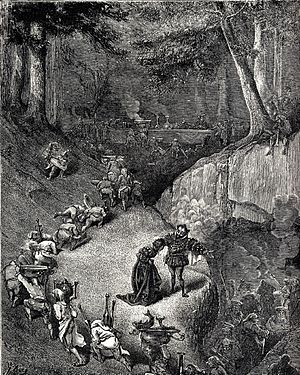Rickey with the Tuft facts for kids

Rickey with the Tuft (also known as Riquet with the Tuft) is a famous fairy tale written by Charles Perrault. It was first shared with the world in Paris in 1697. This story was part of a collection called Histoires ou contes du temps passé, which featured eight fairy tales by Perrault.
The tale tells the story of a prince named Rickey. He is not handsome but is very smart. He meets a princess who is beautiful but not very clever. The story explores how they help each other. Rickey gives the princess intelligence, and in return, she makes him handsome. This tale is a "literary fairy tale," meaning it was created by an author, not passed down through generations. It shares ideas with other well-known stories like Cupid and Psyche and Beauty and the Beast.
Contents
The Story of Rickey with the Tuft
This magical story begins with a prince named Rickey. He was born looking quite unusual, but a kind fairy gave him a special gift. This gift allowed him to make anyone he truly loved very intelligent.
The Two Princesses
Rickey travels to a kingdom where he finds two princesses. The older princess is incredibly beautiful, but she isn't very smart. Her younger sister, however, is very clever, but she isn't as pretty. The older princess often feels sad because her smart sister gets more attention.
One day, the older princess walks in the forest, feeling unhappy. Prince Rickey sees her there and is immediately drawn to her beauty. He asks her why someone so lovely could be so sad. She explains that she is sad because she is beautiful but not intelligent.
A Magical Promise
Rickey, who has fallen in love with her, offers her a deal. He promises to give her his gift of intelligence. In return, she must promise to marry him one year later. The princess agrees, and instantly, she becomes very witty and wise.
A year passes, and Rickey returns to claim his bride. The princess, now much smarter, hesitates. She tells him that she made the promise before she gained her wisdom. She feels she shouldn't be held to a promise made when she wasn't as clever.
The Transformation of Rickey
However, the princess then remembers a special gift she received at birth. The same fairy who helped Rickey had also given her a power. This power allowed her to transform her true love into a handsome man.
As the princess thinks about all of Rickey's good qualities—his kindness, his intelligence, and his love for her—a magical change happens. Right before her eyes, Rickey becomes a handsome prince!
The king is very happy and arranges for his daughter to marry Rickey. Rickey had already prepared everything for a wonderful wedding.

